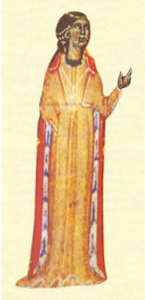Comtessa de Dia facts for kids
Quick facts for kids
Comtessa de Dia
|
|
|---|---|

Beatriz de Dia from Bibliothèque Nationale, MS cod. fr. 12473, 13th century
|
|
| Background information | |
| Native name |
Béatrix de Viennois
|
| Born | c. 1140 Die, Provence |
| Origin | Provence |
| Died | c. 1212 Provence |
| Occupation(s) | Trobairitz |
The Comtessa de Dia (Countess of Die) was a famous female poet and musician from a long time ago. She lived around the late 1100s and early 1200s in a region called Provence in southern France. She was known as a trobairitz, which is the name for a female troubadour. Troubadours were poets and composers who wrote and performed songs, often about love and chivalry, during the Middle Ages.
Who Was the Comtessa de Dia?
Her real name might have been Beatritz or Isoarda. We only know her as the "Comtessa de Dia" from old documents. She was probably the daughter of Count Isoard II of Die, a town in southern France.
According to her vida (a short biography written about troubadours), she was married to William of Poitiers. However, the vida also says she was in love with and wrote songs about a knight named Raimbaut of Orange. Some experts think her songs might have been for Raimbaut's nephew, Raimbaut IV. If so, she might have been encouraging him to support a powerful leader named Raymond V of Toulouse.
Some people also believe she might have been married to William's son, Ademar de Peiteus. They think her true love might have been another famous poet, Raimbaut de Vaqueiras.
Her Amazing Songs
We still have five of the Comtessa's works today. These include four cansos (love songs) and one tenso (a debate song). One tenso, called Amics, en greu consirier, is often thought to be by Raimbaut d'Aurenga. But some scholars believe the Comtessa might have written it. This is because it sounds similar to her own song, Estat ai en greu consirier. Also, her vida says she wrote "many good cansos" about Raimbaut d'Aurenga.
Her song A chantar m'er de so qu'ieu non volria is very special. It is the only canso by a trobairitz that still has its music! This song is in the Occitan language, which was spoken in southern France long ago. The music for A chantar was found in a collection of songs called Le manuscript di roi. This collection was copied around 1270 for Charles of Anjou, who was the brother of King Louis IX of France.
Her surviving poems are:
- Ab joi et ab joven m'apais
- A chantar m'er de so qu'ieu non volria
- Estât ai en greu cossirier
- Fin ioi me don'alegranssa
Themes in Her Poetry
The Comtessa de Dia often wrote about certain topics in her songs. These included being hopeful, praising herself and her love, and sometimes feeling betrayed.
In A chantar, she sings as a lover who has been let down. Even though she feels betrayed, she still defends and praises herself. In another song, Fin ioi me don'alegranssa, the Comtessa makes fun of the lausengier. This was a person known for spreading gossip. She compares gossips to a "cloud that obscures the sun."
When she wrote, the Comtessa used different styles. In A chantar, she used a style called coblas singulars. This means she repeated the same rhyme pattern in each part of the song, but changed the main rhyme sound each time. In Ab ioi, she used coblas doblas, which had a different rhyme pattern.
See also
 In Spanish: Beatriz de Día para niños
In Spanish: Beatriz de Día para niños


